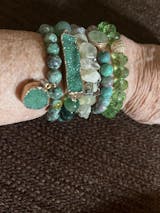Blue stones are joy in color form—open skies, clear water, a breath you didn’t know you were holding. But step into the jewelry world and one question pops up fast: what’s the real turquoise vs magnesite difference? You’ll see both materials in bracelets and stacks that look similar at a glance, yet they carry different backstories, price points, and care needs. This guide breaks the confusion into calm, practical steps you can use at home—no harsh chemicals or destructive tests—plus styling ideas so whichever blue you choose, it earns a permanent spot in your rotation.
First things first: what are you actually looking at?
Turquoise is a copper-aluminum phosphate prized for its robin’s-egg blues and intricate “matrix” (the web or patches of host rock you see on the surface). It’s often stabilized—infused with a clear resin—to improve durability for everyday wear.
Magnesite is a magnesium carbonate that’s naturally white to gray. Jewelers frequently dye it turquoise blue and sometimes add veining to mimic spiderweb matrix. When treated thoughtfully, it delivers a beautiful, even color at an approachable price.
Both can be fashioned into smooth rounds and slices for stacks. In other words: they can look like sisters—until you know what to notice.
The honest why: why the confusion exists
-
Color overlaps. Turquoise spans powder to teal; dyed magnesite is tuned to those same hues.
-
Treatments are common. Stabilized turquoise and dyed magnesite both aim for beauty + durability, which narrows visual differences.
-
Product names vary. You’ll see terms like “turquoise,” “reconstituted turquoise,” “howlite/magnesite,” or just “blue stone.” Clear labeling isn’t universal, especially in mass marketplaces.
That’s why simple, gentle checks matter. They help you make a confident call without damaging your jewelry.
Seven gentle checks you can do at home
1) Color flow (uniform vs lived-in)
Real turquoise often shows subtle shifts—cloudy zones, slightly greener areas near the matrix, a lived-in look. Dyed magnesite leans more uniformly, like paint that covers every pore evenly. If the blue feels perfectly flat across every bead, magnesite (or a heavily dyed material) is likely.
2) Matrix pattern (webs that tell a story)
Turquoise matrix tends to look organic: spiderweb lines that taper and rejoin, or chocolatey patches that respect the stone’s grain. On dyed magnesite, veining can appear more “drawn on” or repetitive from bead to bead. Compare three beads side-by-side—do the patterns repeat? Repetition hints at imitation.
3) Pores and sheen (matte glow vs glassy gloss)
Turquoise (especially stabilized) has a soft, waxy glow. Magnesite can show tiny open pores; when dyed, those pores may hold a slightly darker color. Under bright light, if you notice many tiny pinholes catching dye, you’re likely in magnesite territory.
4) Edge and drill-hole check
Look closely at bead holes and around small nicks. If you see white peeking through a bright blue surface at a sharp corner, the material underneath was lighter—classic for dyed magnesite. Turquoise tends to be blue through, though shades vary naturally.
5) Weight and “temperature”
This is subtle, but many people feel turquoise as a hair denser and “cooler to the touch” for longer, while magnesite warms quickly in the hand. Not definitive alone—use it with the other clues.
6) Naming and price coherence
Suppose the listing promises “AAA natural turquoise, large rounds, bargain price,” pause. Quality turquoise commands a corresponding price. Thoughtful, transparent sellers will label dyed magnesite clearly or use phrases like “turquoise-colored magnesite.”
7) Q-tip sanity check (only on an unseen spot)
Lightly dampen a cotton swab with plain water and touch an inconspicuous edge. You shouldn’t see color lift. If vivid dye transfers to the swab, that piece wasn’t colorfast—a sign of surface dye on magnesite. Don’t rub; this is a check, not a cleaning method.
None of these is a courtroom verdict on its own, but together they paint a reliable picture.
Why magnesite can be a smart, stylish choice
Here’s the part most “how to tell” articles skip: dyed magnesite isn’t the enemy. It’s a versatile material that gives you the breezy blue you love in a durable, budget-friendly format—fantastic for travel, gifting, and daily wear. Think of turquoise magnesite meaning as color + intention: clarity, calm, and honest expression, delivered in a way you don’t have to baby.
Suppose you love the look and story of turquoise but want a consistent hue for stacking. In that case, magnesite can be your uniform—especially in curated sets where the beadwork, accents, and proportions do the heavy lifting.
When turquoise is worth the splurge
Go turquoise when you want irregular beauty—the kind that shows up as nuanced color, complex matrix, and a slightly different personality bead to bead. If you collect, if you love pieces that age with you, or if the stone’s heritage speaks to you, turquoise is the heirloom lane. Stabilized pieces balance wearability with that lived-in charm.
Styling ideas for any blue you choose
-
Office glow: Pair three slim strands (two neutral crystals, one blue) with a tailored blazer. The blue reads like bright eyes on your wrist—fresh and intentional.
-
Dinner light: Add a druzy-accent bracelet to introduce fine sparkle without tipping into party costume.
-
Weekend ease: All five bracelets for movement with a knit dress and sneakers. Blue plus ivory plus denim will be your forever trio.
Prefer ready-made harmony? Explore the turquoise-rich Turquoise Beaded Bracelet Set and then add a neutral shimmer like the Gold Crystal Beaded Bracelet Set. Two sets, endless mixes of handmade turquoise bracelets tailored to your week.
Care tips that keep blue beautiful
-
Roll on, don’t pull. This preserves stretch and prevents micro-cracks at drill holes.
-
Last on, first off. Perfumes, lotions, and hairsprays should go on before bracelets.
-
Gentle clean. Lukewarm water, a drop of mild soap, and a soft cloth. Skip ultrasonic cleaners and harsh dips.
-
Store with breathing room. Let druzy faces and metal accents rest separately so surfaces don’t rub.
Follow those basics and your blue—turquoise or magnesite will keep its calm glow for seasons.
A calm buyer’s checklist (so you feel good at checkout)
-
Read the description. Are materials named plainly? “Turquoise-colored magnesite” is honest and helpful.
-
Scan photos up close. Check edges, holes, and pattern variety.
-
Match price to promise. Quality claims should align with cost.
-
Ask one clear question. “Is this stabilized turquoise or dyed magnesite?” A transparent seller will answer in kind.
-
Buy what you’ll wear. The right piece is the one that lives on your wrist, not in a drawer.
That last line is everything. Your jewelry should meet your life, not ask you to tiptoe around it.
Summer, but make it seasonless.
Blue stacks are the definition of calming crystal jewelry in July—linen, straw totes, road-trip playlists—but they’re just as valuable in October with black turtlenecks and oat coats. If you want a look that bridges seasons:
-
Summer: turquoise + ivory + gold details = breeze on the wrist. That’s summer turquoise jewelry trends without trying.
-
Fall/Winter: turquoise + champagne crystal + black. The blue becomes the smile in an all-neutral outfit.
-
Spring: mix turquoise with rose quartz for a fresh, botanical palette that still reads sophisticated.
Quick comparison: how they behave in stacks
Turquoise
-
Color: nuanced, with natural clouds and shifts
-
Matrix: organic webs/patches, non-repeating
-
Vibe: heirloom, collected, every piece a little different
-
Best for: the collector, the meaning-driven wearer, the texture lover
Magnesite (dyed)
-
Color: consistent, easy to match across strands
-
Matrix: can be painted or uniform; great for clean color stories
-
Vibe: modern, graphic, budget-friendly
-
Best for: the traveler, the maximalist stacker, the uniform-builders
Both deliver that open-sky mood. Choose by personality and lifestyle.
Gift notes (so your message lands)
If you’re gifting turquoise, your card can talk about truth-telling and confident calm. If you’re gifting magnesite, talk about color that carries you through the day—clarity, easy joy, and a stack that always looks composed. Either way, you’re giving someone a small ritual: slide on the bracelets, take a breath, step out the door.
For easy, sure-thing presents, start with curated Bracelet Stacks, then choose blue as the hero and add one neutral shimmer strand. It’s an elegant two-step to a set they’ll wear on repeat.
The takeaway
The turquoise vs magnesite difference isn’t about right vs wrong; it’s about story and fit. Turquoise offers irregular beauty and heritage, while magnesite provides a consistent, stack-friendly blue with effortless styling. Both can be meaningful, durable, and unmistakably you when they’re thoughtfully designed and cared for.
Pick the path that makes you excited to get dressed. If that’s turquoise, let the matrix tell its tale. If that’s magnesite, embrace the perfect color hit. Either way, blue brings the same quiet promise to your day: clarity you can feel, and a wrist that looks intentionally, beautifully finished.







